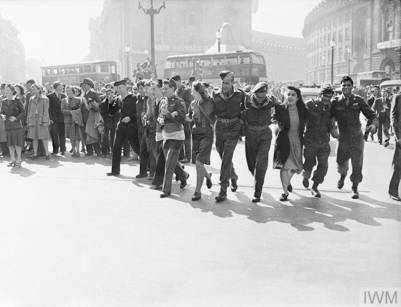
VJ Day 2025: The 80th Anniversary
We are delighted to be a part of the commemorative events for VJ Day 2025.
Discover how you can mark the 80th anniversary of the end of the Second World War in Asia.
EVERY STORY FOR EVERMORE
Marking VJ Day 2025
As we approach the 80th anniversary of VJ day, we consider the impact today of one of the most gruelling campaigns of the Second World War. Commonwealth forces from across the then British Empire came together to fight in Southeast Asia - representing an enormously broad and diverse section of society, fighting for the freedom and values we enjoy today.
While VE Day meant victory in Europe, the war raged on in the Pacific, ending on 15 August 1945, with the Japanese surrender. The official end of the war was two weeks later on 2nd September. The cost was staggering – over 580,000 Commonwealth service personnel died during the war, with more than 41,000 of those deaths occurring after VJ Day as the war continued in the Pacific.

Over half a million African soldiers, porters, drivers and labourers served in the Second World War from the African deserts to the campaign in Burma.
How to get involved

80 Stories to VJ Day:
Private Eric Hutchins
Eric was one of seven Australian brothers who enlisted in the Second World War. Eric and three of his brothers did not return home. Every story for evermore.

Download the For Evermore app
Discover our sites through our new mobile app. With more than 75 guided tours of some of our most well known sites around the world, you can visit virtually or in person, and discover the stories of the people we commemorate.

Support our work
By supporting the Commonwealth War Graves Foundation, you can help us pass on the stories of those who died in the world wars to the next generation. Find out how your support helps us keep their stories alive.

Read their stories on For Evermore
We've got more than 6000 stories in For Evermore, our stories portal. Explore the stories of the men and women we commemorate and discover how you can share your own story of a loved one or family member.
VJ Day events and Commemorative Services
 The 80th anniversary of VJ Day and the end of the Second World War is an incredible opportunity to engage with the next generation and highlight the importance of preserving the stories of the men and women of the Commonwealth who died during the war.
The 80th anniversary of VJ Day and the end of the Second World War is an incredible opportunity to engage with the next generation and highlight the importance of preserving the stories of the men and women of the Commonwealth who died during the war.
Over the coming weeks, we'll be releasing news about commemorative services and engagement events at our sites around the world, where you'll be able to join us to commemorate those who lost their lives in the war.
Our Torch For Peace will be travelling to Asia and will form a part of a number of VJ Day events. It ensures that the legacy of those who fought in the great wars is never forgotten. Their gift of hope and peace that came at such a cost now passed on to future generations. It is a living flame that represents the courage and enduring human spirit of those who died for us. Those whose stories must always be told. For evermore.
 Key Victory in Japan WW2 sites to visit
Key Victory in Japan WW2 sites to visit
Our sites in the Pacific are some of our most well known and well visited WW2 memorials in Asia.
These sites are often found in picturesque areas of the world with flora and fauna that is a far cry from our sites across Europe.
Despite these differences, the men and women we commemorate there are cared for by the same expert teams to the same high standards that you’d find in any of our sites around the world.
Our new For Evermore app delivers some of our most iconic sites into the palm of your hand: Discover 75 guided tours of our sites around the world – including some of our most well-known sites in Asia. Take the app with you when you visit for a guided tour of the site or use the app to explore from the comfort of your own home. Discover the stories of the men and women we commemorate this VJ Day.
Explore these sites virtually through our new app Discover VJ Day memorials to visit
The history of VJ Day, 1945
By the summer of 1945 the world had been gripped by war for six long years. In May, a light had emerged at the end of the tunnel, the end of the war in Europe. Following Germany’s surrender, the Allies were striving for victory in the Pacific.
It would take several more months of fighting and the loss of tens of thousands of lives, military and civilian, and the final cataclysmic use of two atomic weapons, on Hiroshima and Nagasaki, to compel Japan to surrender on 15 August. Two weeks later, on 2 September, Japan’s formal surrender was taken onboard the American battleship USS Missouri in Tokyo Bay.
Over 542,000 Commonwealth servicemen and women had died since the beginning of the war and the Japanese surrender.
VJ Day timeline
26 July 1945
The Potsdam Declaration
The United States, Britain and China issue the Potsdam Declaration, demanding unconditional surrender, the disarmament of Japanese military forces and the removal of Japanese authority over territories other than the islands of Japan as well as other terms of surrender. Although there was some debate by the Japanese leadership, they chose not to accept the declaration.
6 August 1945
The bombing of Hiroshima
At 8:15 local time, the first atomic bomb was dropped on Japan. It was dropped on the city of Hiroshima, causing immeasurable damage and killing tens of thousands of Japanese citizens and military personnel.
In America, President Harry S Truman announced the use of this new weapon, promising “a rain of ruin from the air, the like of which has never been seen on this earth”.
9 August 1945
Soviet Declaration and bombing of Nagasaki
In a twin blow to the Japanese leadership, two events combined to force their hand.
The Soviet Union ended their neutrality and declared war on Japan, invading Japanese-controlled Manchuria and adding their support to the Potsdam Declaration.
On the same day, the Americans dropped the second atomic bomb of the war on the city of Nagasaki. As with the attack on Hiroshima, the attack killed tens of thousands, destroying much of the city.
Faced with these two blows, the Japanese cabinet met to discuss ending the war.
10 August 1945
Signal to surrender
In the early hours of 10 August the Japanese cabinet, guided by Emperor Hirohito, decided to accept the Potsdam Declaration, although it would push for an arrangement that ensured that the Emperor would remain in position.
With the decision taken, telegrams were sent via Switzerland, beginning the negotiations for surrender.
14 August 1945
Japan surrenders
Despite much negation and debate, full terms of surrender had yet to be agreed. Air raids on mainland Japan had been paused and replaced by leaflet drops, but on the 14th, the Americans carried out an immense bombing raid with more than 1000 aircraft.
With internal unrest, and the ever-present threat of atomic bombs, the Emperor and the rest of the Japanese leadership chose to accept the Allied surrender demands and the signals were sent.

15 August 1945
VJ Day
At noon on the 15th, a broadcast recorded the previous night was heard across Japan. For the first time, the Japanese people heard the voice of their Emperor as he announced the surrender.
Although some fighting continued – notably the Soviet invasion of Japanese territory - around the world, people gathered to celebrate the end of the war.
Image: IWM (D 25636) VJ day - Britain hears news of end of Japan war: Celebrating victory in Japan, London, England, c 15 August 1945.

2 September 1945
Formal declaration of surrender
The official surrender was carried out on the deck of the USS Missouri in Tokyo bay. Missouri was accompanied by 250 other vessels, including those representing some of the Allied nations, with dignitaries and military officials of each nation in attendance.
Image: IWM (A 30425) Japanese surrender at Tokyo Bay, 2 September 1945
What happened on VJ Day, WW2?
While many nations commemorate VJ Day on 15 August, others observe the anniversary on 2 September.
15 August was the day when hostilities ceased. The Japanese commanders surrendered to the Allied nations via communications through Switzerland, and Emperor Hirohito made a radio broadcast for the first time, informing the Japanese citizens of their surrender.
Across the globe, there were massive public celebrations. While the VE Day celebrations months before had had a bittersweet tinge, with many unable to fully rejoice knowing that their loved ones were still fighting, by 15 August, they knew that the war was all but over, and their friends and family members would soon be home.
2 September saw the official signing of the Japanese Instrument of Surrender, the written agreement formalising the surrender. On the desk of the battleship the USS Missouri, at anchor in Tokyo Bay, Allied and Japanese officials signed two copies of the surrender, with representatives of the major combatants of the war in attendance.
What happened after VJ Day?
One of the biggest considerations for the Allied High Command on VJ and in the following weeks was the freedom and recovery of the prisoners of war who were being held in camps across Japanese territory.
Bombers that had so recently been dropping bombs on the Japanese mainland were repurposed, dropping supplies to former prisoners waiting to be brought home from their camps.
Allied forces began the occupation of Japan shortly after the surrender, with more than 400,000 American soldiers stationed throughout Japan by the end of 1945 with a further 40,000 Commonwealth troops following in 1946.
Even after surrender, service personnel continued to die. Millions were still in uniform, serving at home and abroad. Prisoners of War had to be repatriated, occupation and control forces were deployed, and wounds, sickness and accidents continued to take their toll.
As a result, we commemorate over 41,000 service personnel who died between VJ Day and 31 December 1947, the end of our period of responsibility.
During the war, deaths had been recorded and graves marked by the military authorities. These records and burial grounds were handed over to the Commission to make permanent.
It was not until 1968, that the Commission’s last Second World War memorial was unveiled in Ambon, Indonesia.
Today, it is our role to commemorate these service personnel and civilians. To acknowledge and preserve their memory and sacrifice. To say for evermore that these people were here in a time and place now past, but which shall be remembered. To pay, in part, the debt of honour which was owed by the living to the dead for the terrible price of securing peace.
Why do we commemorate the VJ day anniversary?
The deadly cost of war is seldom confined to the battlefield.
During the Second World War as in many others, the civilian populations suffered famine, disease, displacement and death.
Tens of thousands of Commonwealth civilians had died during the Blitz on British towns and cities in 1940 and in the Bombing of Darwin, Australia by the Japanese in 1942. They were lost at sea in ships mined or sunk by torpedoes. They were killed in fighting as enemy troops overran towns and cities in western Europe, Hong Kong, Malaya and Singapore. They died of disease, maltreatment and poor conditions whilst held in internment camps. In accidents in the hazardous tasks of the manufacture and transportation of munitions.
Today the Commission commemorates over 68,000 Commonwealth civilian men, women and children in its Civilian Roll of Honour, held at Westminster Cathedral. A record which is known to be incomplete due to difficulties in reporting casualties and which only lists those who lost their lives as a direct result of the conflict.
The indirect cost was incalculable and likely far greater around the world.
Remembering VJ Day WWII

VJ Day is an opportunity to pay tribute to the men and women who died during the campaign in the Pacific. Their stories pay tribute to their bravery and tenacity but also tell the stories of ordinary men and women who went above and beyond in service to their countries.
Lieutenant William Basil Weston of the Green Howards (Yorkshire Regiment) is one such story, recorded on our For Evermore stories portal.
On 3 March 1945 during the attack on Meiktila, Burma, Lieutenant Weston was commanding a platoon which, together with the rest of the company, had to clear an area of the town of the enemy. In the face of fanatical opposition, he led his men superbly, encouraging them from one bunker position to the next.
When he came to the last, particularly well-defended bunker, he fell wounded in the entrance. Knowing that his men would not be able to capture the position without heavy casualties he pulled the pin out of one of his grenades as he lay on the ground and deliberately blew himself up with the occupants of the bunker.
Lieutenant Weston is buried in our Taukkyan War Cemetery, alongside more than 6,300 of his comrades from across the Commonwealth.

